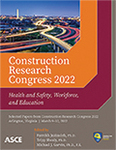Preventative Safety Metrics with Highway Maintenance Crews
Publication: Construction Research Congress 2022
ABSTRACT
What gets measured, gets improved. This applies to safety in the construction industry, where the primary measure of safety performance of construction workers is the OSHA recordable incidence rate. While this reactive metric is important to understand the frequency of injuries, it does not assist in managing the safety, health, and overall well-being of construction workers. Therefore, researchers encourage using metrics that assist in indicating a higher likelihood of an injury occurring since such metrics would be more beneficial to improving safety and health. While proactive safety performance indicators have been extensively discussed in the literature of construction research, minimal attention has been paid to using these metrics in the highway construction and maintenance sector. This study addressed this gap by developing a holistic action-ready mechanism to assess safety performance of highway maintenance personnel in Kentucky. Using the analytic hierarchy process analysis (AHP), 5 metrics and 65 leading indicators were selected and weighed to proactively reflect the safety performance of the targeted workforce. The final product of the study is a scorecard used to assess safety performance of Kentucky highway maintenance crews on a district level, an area level, and a program level. This study provides a useful proactive tool that can be used by States DOTs to assess safety performance of their maintenance crews. In addition, the study contributes to the body of knowledge by discussing the use of proactive performance metrics in the highway construction and maintenance sector.
Get full access to this article
View all available purchase options and get full access to this chapter.
REFERENCES
Ahmad, R. K. (2000). Developing a proactive safety performance measurement tool (SPMT) for construction sites. Loughborough University.
Akroush, N. S., and El-Adaway, I. H. (2017). “Utilizing construction leading safety indicators: Case study of tennessee.” Journal of Management in Engineering, 33(5), 06017002.
Al-Harbi, K. M. A.-S. (2001). “Application of the AHP in project management.” International journal of project management, 19(1), 19–27.
Al-Shabbani, Z., Sturgill, R., and Dadi, G. B. (2018). “Developing a pre-task safety briefing tool for Kentucky maintenance personnel.” Transportation research record, 2672(12), 187–197.
Awolusi, I. G., and Marks, E. D. (2017). “Safety activity analysis framework to evaluate safety performance in construction.” Journal of Construction Engineering and Management, 143(3), 05016022.
Biggs, H. C., Dinsdag, D., Kirk, P. J., and Cipolla, D. (2010). “Safety culture research, lead indicators, and the development of safety effectiveness indicators in the construction sector.” International Journal of Technology, Knowledge and Society, 6(3), 133–140.
Felix, G. H., and Riggs, J. L. (1983). “Productivity measurement by objectives.” National Productivity Review, 2(4), 386–393.
Hale, A. (2009). “Why safety performance indicators?” Safety Science, 4(47), 479–480.
Hallowell, M. R., Hinze, J. W., Baud, K. C., and Wehle, A. (2013). “Proactive construction safety control: Measuring, monitoring, and responding to safety leading indicators.” Journal of construction engineering and management, 139(10), 04013010.
Hinze, J. (2002). “Safety plus: making zero injuries a reality.” Construction Industry Institute, 160–111.
Hinze, J., Thurman, S., and Wehle, A. (2013). “Leading indicators of construction safety performance.” Safety science, 51(1), 23–28.
Leveson, N. (2015). “A systems approach to risk management through leading safety indicators.” Reliability Engineering & System Safety, 136, 17–34.
Manuele, F. A. (2009). “Leading & lagging indicators.” Professional Safety, 54(12), 28.
Michael, J. H., Evans, D. D., Jansen, K. J., and Haight, J. M. (2005). “Management commitment to safety as organizational support: Relationships with non-safety outcomes in wood manufacturing employees.” Journal of safety research, 36(2), 171–179.
OSHA. (2016). “Recommended Practices for Safety & Health Programs in Construction.” <https://www.osha.gov/shpguidelines/>. (05/01/2020, 2020).
Shea, T., De Cieri, H., Donohue, R., Cooper, B., and Sheehan, C. (2016). “Leading indicators of occupational health and safety: An employee and workplace level validation study.” Safety science, 85, 293–304.
Stricoff, R. S. (2000). “Safety peformance measurement: Identifying prospective indicators with high validity.” Professional Safety, 45(1), 36.
Wachter, J. K., and Yorio, P. L. (2014). “A system of safety management practices and worker engagement for reducing and preventing accidents: An empirical and theoretical investigation.” Accident Analysis & Prevention, 68, 117–130.
Wehle, H., and Hinze, J. (2009). A survey of leading indicators among the members of the CII safety community of practice. Construction Industry Institute. Austin, TX.
Information & Authors
Information
Published In
History
Published online: Mar 7, 2022
Authors
Metrics & Citations
Metrics
Citations
Download citation
If you have the appropriate software installed, you can download article citation data to the citation manager of your choice. Simply select your manager software from the list below and click Download.
